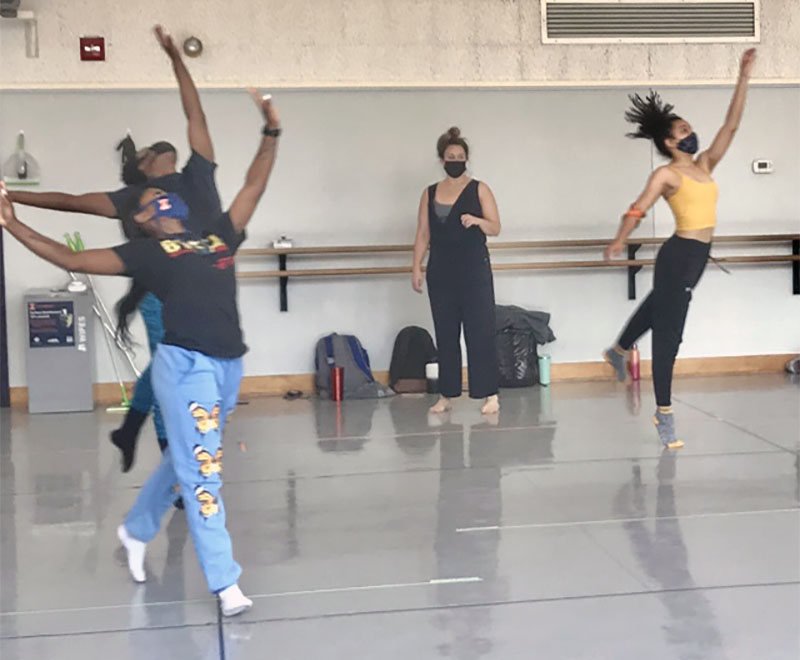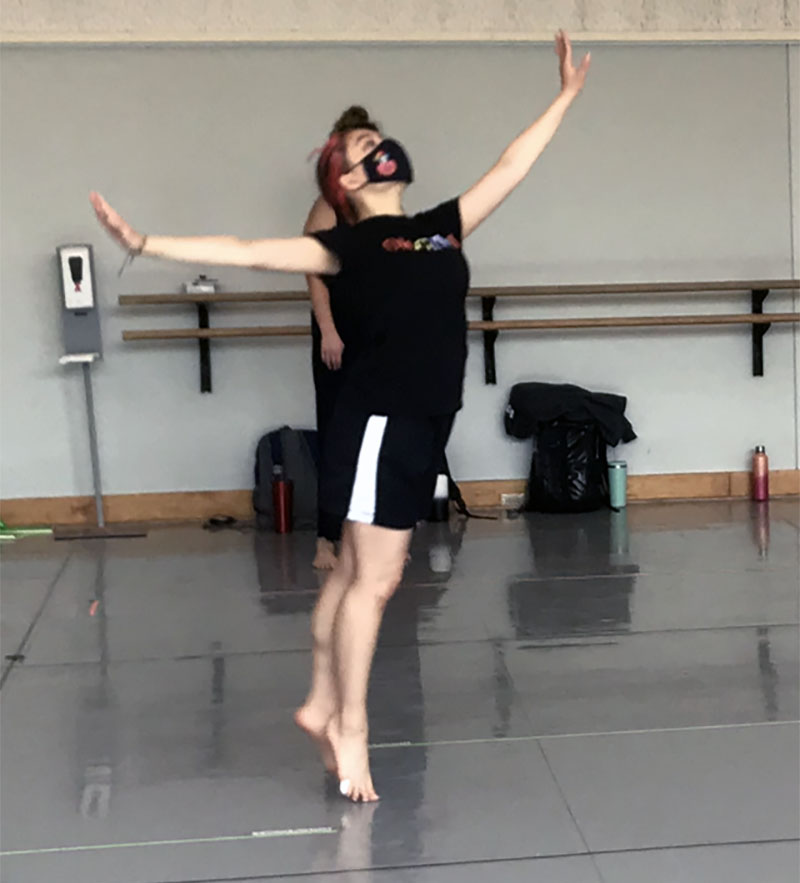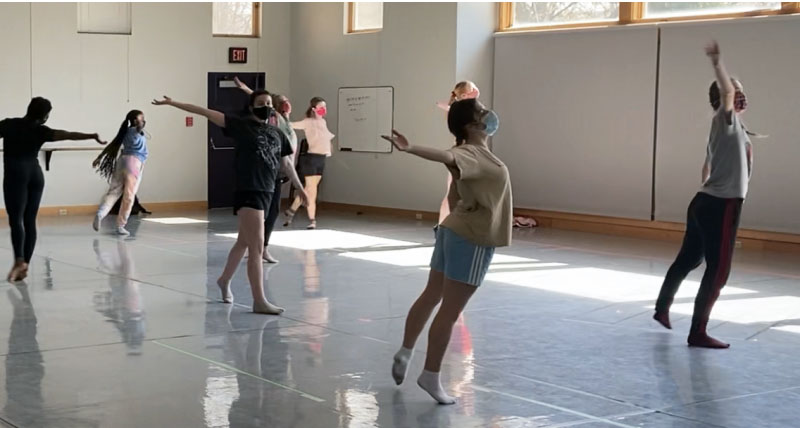Inspired by the ways in which COVID-19 has transformed what it means to learn and work in the performing arts, Performing Your Art in a Pandemic invites C-U performing arts students to share their experiences, be they frustrating, surprising, or inspiring. If you have suggestions, ideas, or feedback, feel free to contact us at [email protected].
Just over a year ago, when anticipation of the quarantine lock-down buzzed around the University of Illinois Urbana-Champaign campus, I watched as my students entered the dance studio for what seemed like it could be the last time of the semester. I was teaching Tap 100, a course offered to dance majors as well as students majoring in other disciplines, and we were just getting to the best part—basic skills were being mastered and dancers were advancing to new levels of expertise. With tones ranging from somewhat forced positivity to disappointment and disbelief, we all asked the same question: How are we going to take a dance class online?
At that point, while not for lack of ideas, no one had a real answer.
Now, one year in (and feeling hopeful that there is a light at the end of the tunnel) there are some crucial lessons I have learned teaching dance through a global pandemic:
While dancing at home is not ideal, it is not impossible. It’s true that some dance forms translate better to this environment. Practicing a ballet barre exercise while using the back of my kitchen table chair for stability can in many ways simulate the experience of being in a ballet class, but I did not find a way to teach or take a tap class without making my downstairs neighbor… frustrated. This brought up a lot of questions about accessibility in a non-pandemic world. Do online dance classes provide an option to dancers who would otherwise have no access for reasons of proximity or disability, for example? At the same time, does a potential demand for ongoing, online dance classes jeopardize dance styles that rely on a particular method of making rhythms, loud volumes, or embodied community that is more difficult to translate over Zoom?

Photo by Kayt MacMaster.
The dance community is incredibly adaptable. We like to say that our training in performance and improvisation makes us ready to take on the most unpredictable of situations, and a global lock-down was a real test of this claim. I have watched as teachers and students turned their apartments, backyards, offices, and garages into functional dance spaces overnight. Within a month of quarantine, organizations like Movement Research and Free Skewl brought renowned teachers to everyone’s computer screen for donation-based classes where students could not only hone their craft but also scroll through the gallery of faces and see friends they have danced with from around the country and even around the world. Similarly, the University of Illinois Dance Department had classes up and running on Zoom one week after campus officially shut down. There was incredible care given to maintaining some sense of normalcy and comradery for students while understanding that there was nothing normal about the situation.
Performance is a major component of most approaches to dance education. While it is often the most fun part of dancing, I have at times questioned this tenet because it can breed unhealthy comparison and competition between dancers. However, teaching through a pandemic has illuminated what may be the most crucial skill set developed through the performance process: Collaboration. Whether dancing on a stage, in an outdoor setting, or performing in a dance for the camera, it can rarely be done in isolation. Complying with CDC guidelines for live performances has called in a whole new level of personal accountability and interdependence. Dancers who performed in the live concerts this year on campus not only agreed to be present in the rehearsal process, they also agreed to make everyone’s health and safety their priority. This experience has heightened my appreciation for the various levels of collaboration involved in making a performance happen, and I hope to continue acknowledging this long into the future. From a teaching perspective, it may act as an antidote to less enriching aspects of performance like perfectionism and unhealthy competition.

Photo by Kayt MacMaster.
These lessons are just the tip of the iceberg, but I must also affirm that I owe my most successful teaching practices and inspiring moments in the classroom to my colleagues and students. They are tenacious artists who have used the past year to reflect, innovate, and adapt. If you were to walk through campus at any point in the past year, you would pass through a veritable treasure map of performing artists continuing to perform. Dance technique classes happened on an outdoor basketball court. Spirits were kept high with the grooviest live accompaniment in town. Under the tutelage of dance faculty member Sara Hook, sophomore choreographers created their first dances, bravely showing their works-in-progress on the terrace of the Krannert Center and in the arboretum. A graduate colleague and I spent the better part of last April composing new solo performances for our composition course using outdoor industrial or agricultural sites around campus as both inspiration for the movement and for the setting of our final projects. Studio Art faculty member, Deke Weaver, has transposed his renowned course on performance art into an outdoor adventure where students meet weekly and hike to a location on campus. Dressed for any weather, they generate performance material through socially-distanced collaboration with each other and the environment. And I would be remiss to neglect what is happening inside the dance studio, where we have been extremely fortunate to meet and dance together as a community under strict observation of CDC guidelines. While some may see the protocols as a limitation, full-bodied dancing has been transposed from the typical open space of the studio to the confines of social distancing and mask-wearing and resulted in rigorous investigations of what it means to dance in a room with others. And — believe me — in a ballet class like Tere O’Connor’s and a modern class like Cynthia Oliver’s, you’re working up the same sweat you would be under any other circumstances.
Thinking back to what ended up being our last tap class together of the 2020 spring semester, we considered not dancing and instead taking the time to talk about everything that was about to happen. Instead, everyone opted to dance. We danced the tap combination we had been working on over and over again, taking turns calling out different songs to try as accompaniment. It was 9 o’clock in the morning, a notoriously brutal time to take a tap class, but no one was sleepy or taking it easy on that day. We danced greedily, knowing that we were getting a kind of nourishment that we may not have access to again for a long time.
So, I suppose my final lesson from this year is a reminder to not take time or opportunities for granted, and that includes time and opportunities for rest. There is a particular kind of magic that comes from the right combination of creativity and grit, and sometimes it takes a major shift in perspective to see and appreciate it.








